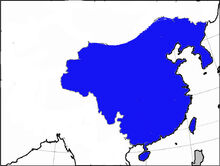The Han Dynasty (L'Uniona Homanus)
Posted By Drs. H.Mutawalli, M.Pdi From Indonesian
| |||||||
| Religion: | Confucianism and other minority mystic religions | ||||||
| Demonym: | Sinican | ||||||
| Type of government: | Monarchy | ||||||
| government: | Emperor | ||||||
| First Emperor: | Emperor Gaozu 高祖 | ||||||
| Royal house: | House of Liu 劉 | ||||||
| Established: | 533 (220 BC) | ||||||
Contents |
The Foundation of the Han Dynasty Edit
Edit
The Han Dynasty followed after Emperor Qin Er Shi 秦二世 died and the Empire fell apart. The large area of Chu, which used to be independent before they were conquered by the Emperor Qin Shi Huang 秦始皇, became independent and the general Liu Bang 劉邦 took control of the areas that weren't controlled by the Chu King, Huai II, and then proceeding to take the Chu Kingdom for himself. General Liu Bang became Emperor Gaozu 高祖 and the Han Dynasty began to expand the Empire more than it did in OTL.
List of Emperors of the First Han Dynasty Edit
Edit
Emperor Gaozu 高祖 533-547 (220-206 BC)
Emperor Hui 惠 547-570 (206-188 BC)
Emperor Qianshao 前少 570-593 (188-160 BC)
Emperor Zhangshao 张少 593-623 (160-130 BC)
Emperor Wu 武 623-631 (130-122 BC)
The Second Warring States Period Edit
Edit
After the death of Emperor Wu in the Han Civil War the different coutnries were not able to be held together by the emerging general Cao Wei and the actual murderer of Emperor Wu, and usurper of his throne, named Bohai. Bohai was killed by Cao Wei but there were already so many conflicts taking place simultaneously across the Empire that Cao Wei cut his losses and took to the Norther Provinces to establish the new Kingdom of Bei. The war between Bei and Koraen separatists ended with the emergence of the independent Kingdom of Korea, another fractured part of the Han Empire. Severall smaller Kingdoms existed throughout the continent and these would engage in regular warfare with each other leaving their political situation so muddied by death and estruction that hardly anyone could sit together to establish any lasting peace on the continent.
The smaller kingdoms, which were trying as best they oculd to defend themselves from their larger neighbors, came together in what was called the Treaty of Xi'an, which provided military protection from the Private Military Orders to move across the borders of these smaller Kingdoms. This would build a larger relationship on the Continent which would be used to almost reunify the coutnry after the Sino-Japanese War.
The Sino-Japanese war marked an interruption between the Warring states period, though after the end of this time the Sinicans began to feel more closely related, as they had to work together to defeat the Japanese Empire. The end of this time begins what is called the Third Warring states Period, though some parts of it were actually engaging in the creation of coutnries which would grant peace to the Sinicans.
The Third Warring States Period Edit
Edit
The Third Warring States period starts when the Crimson Dynasty of the United Kingdom was made, wherein the Kingdoms of Xi, Chu, Wei, and Han joined into one United Kingdom and each coutnry would rotate the office of King at the death of the last. The Kingdom of Yan joined the alliance afterwards. As this was happening the Song-Tang Commonwealth was being built between the strong countries of Song and Tang. The Kingdoms of Nan and Bei remained militarily powerful but a shadow of their former selves. The Korean Empire, though it barely extended past the Korean Peninsula, stilll existed and the Independent Mongol state began to emerge from the Japanese Colony. The Srivijaya, a close ally of the Japanese, also emerged in South East Asia.
This period was marked by the growth of new coutnries and the uniting of old ones, but it would live up to its name. The Song-Tang Civil War which grew into the Great Sinican War would be said to "stain the earth with the blood of soldiers for thirty generations." These were not by any means truly peaceful times. The United Kingdom began to centralize power back into the hands of the supposed descendent of the former emperors. The Han Kingdom emerged to be the most powerful in the UK and they crushed any who oppposed them, such as the Kingdom of Xi in the central moutnains.
The Second great Sinican war would lead to the emergence of the msot powerful general to grace the continent and the msot compicated conflict that the Sinicans had to fight. Though it started as a mvoe against the Song-Tang Commonwealth, who had forgotten their good fortune in still being independent from the Untied Kingdom, it quickly moveed as a conlict against the Kingdom of Nan, The Srivijaya, and The Japanese especially. King Keqiang became the first Emperor in the Second Han Dynasty and though it was technically smaller than the first Han Dynasty, it was the start of the Longest period of peace Sinican would had had for a long time.


